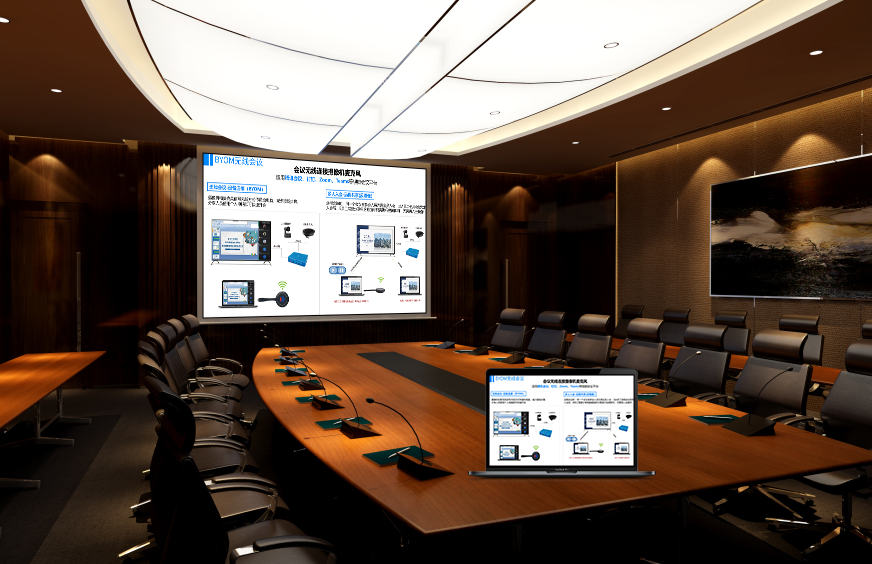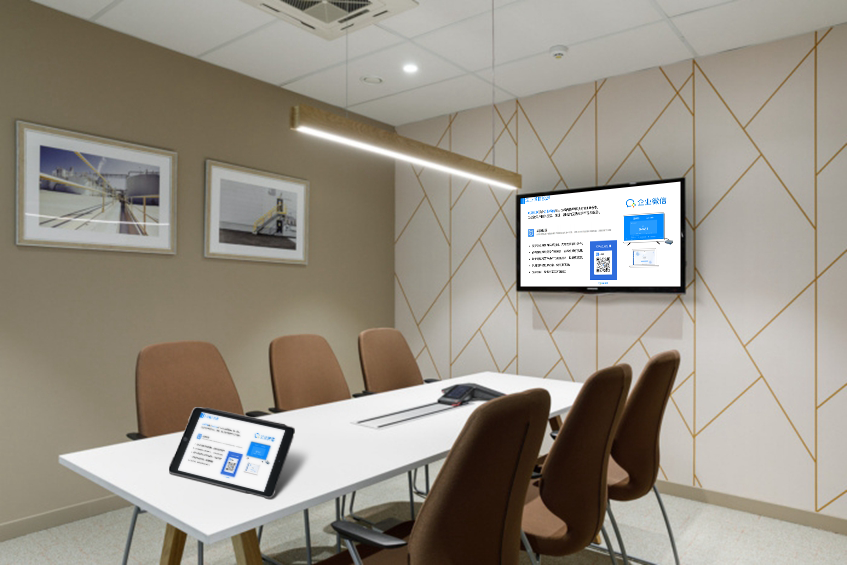Wireless Screen Mirroring: A Solution for All-Scenario Device Interconnection
Wireless screen mirroring technology has been upgraded to be the core link for all-scenario device interconnection. Addressing pain points in office, education, retail, and home scenarios, it provides a complete solution that covers hardware adaptation, function optimization, and scenario implementation. This delivers a flexible experience of “content wherever, display wherever.”
I. Office Meeting Solution: Efficient, Boundaryless Collaboration
(I) Addressing Core Pain Points with a Solution
The solution tackles the problems of “time-consuming connections, cumbersome switching, and disjointed remote meetings” in traditional conferences by using a “three-screen linkage” architecture:
- Quick Start: Proximity sensing technology allows a pop-up window to appear automatically when a device is near the conference screen, reducing connection time from 5 minutes to 10 seconds.
- Multi-Stream Split-Screen: It supports 4 devices mirroring at the same time. The main screen can display PPTs, data, and a video conference feed in a split-screen view, boosting decision-making efficiency by 60%.
- Remote Collaboration: The cloud meeting function enables a split-screen display of the remote video and local content. Phone annotations are synchronized in real time, making remote collaboration feel like working on-site.
(II) Hardware Adaptation Scheme
- Small Conference Rooms (5-10 people): A 32-55-inch touch screen + a mirroring module to meet the needs of quick discussions.
- Medium Conference Rooms (10-30 people): A 65-86-inch 4K screen + camera + microphone, supporting facial check-in and automatic meeting recording.
- Large Lecture Halls (50+ people): A dual-screen linkage, with the main screen displaying content and the side screen showing annotations and voting results.
II. Smart Education Solution: A New Model for Interactive Classrooms
(I) Addressing Pain Points in Teaching Scenarios
The solution tackles the problems of “one-way delivery, low participation, and delayed feedback” through “two-way interaction”:
- Teacher-Student Linkage: After a teacher mirrors their screen, student answer data generates a dashboard in 3 seconds. High-frequency incorrect questions automatically trigger the push of similar examples.
- Group Collaboration: Up to 6 group terminals can connect simultaneously. Their work can be mirrored in turns or in a split-screen comparison, making differences clear at a glance.
- Resource Consolidation: Class recordings are linked to the mirrored content. Students can scan a QR code to review the courseware with annotations after class, improving review efficiency by 50%.
(II) Hardware Deployment Scheme
- Regular Classroom: A projector + a mirroring box to support basic multi-device interaction.
- Advanced Classroom: An 86-inch smart whiteboard + an answer pad to enable integrated annotation and multi-solution comparison.
- Outdoor Classroom: A portable projector + a 4G terminal, supporting a direct hotspot connection in a no-network environment for real-time analysis of experimental phenomena.

III. Retail Display Solution: A New Path for Marketing Conversion
(I) Core Demands of Retail Scenarios
The solution builds a closed-loop of “experience – interaction – conversion,” addressing the problems of “inefficient display, weak interaction, and lack of data”:
- Dynamic Display: Mirroring a 3D model or operational data from a phone is 3 times more persuasive than a static poster.
- Instant Interaction: Customers can scan a QR code to vote, and the results are instantly generated as a chart, boosting the conversion rate by 40%.
- Data Consolidation: The system records dwell time and interaction frequency to optimize display strategies.
(II) Hardware Implementation Scheme
- Small Store: A 55-65-inch wall-mounted screen + a mirroring module for low-cost dynamic displays.
- Experience Store: A transparent screen + multi-screen linkage to match personalized needs.
- Exhibition Site: A portable screen + a 4G mirroring device, supporting up to 10 devices connecting simultaneously.
IV. Home Entertainment Solution: A New Upgrade for Immersive Experiences
(I) Optimizing the Home Scenario Experience
The solution addresses the problems of “inconvenient switching, out-of-sync audio/video, and difficult operation” through “ecosystem integration”:
- Cross-Device Flow: Phone content is seamlessly mirrored to the TV, with consistent operation across multiple terminals.
- Multi-Screen Interaction: The TV, speakers, and phone are linked, providing an immersion comparable to a cinema.
- Elderly-Friendly: Voice commands can be used to start mirroring, and visual guidance on the large screen lowers the barrier to entry.
(II) Hardware Combination Scheme
- Basic Version: A smart TV + a mirroring device to meet basic needs.
- Advanced Version: A 4K TV + a soundbar + a gateway, supporting multi-device synchronization.
- Whole-House Version: Multiple TVs in different rooms are linked, and a phone can control playback in each area.
The core of the wireless screen mirroring solution is adapting technology to the scenario. Through customized hardware, optimized functions, and data linkage, it ensures that device interconnection precisely matches the needs of each scenario, delivering a dual upgrade in efficiency and experience.